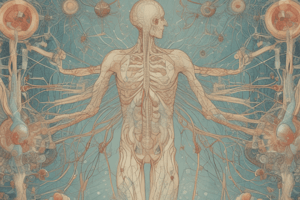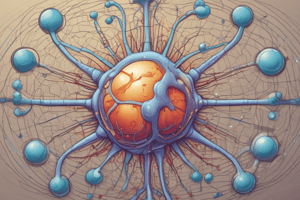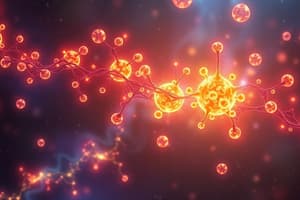Podcast
Questions and Answers
Which of the following is a therapeutic use of cholinesterase inhibitors?
Which of the following is a therapeutic use of cholinesterase inhibitors?
- Treatment of Alzheimer's disease (correct)
- Treatment of hypertension
- Treatment of diabetes
- Prevention of headaches
What condition is characterized by an autoimmune neuromuscular disorder leading to fluctuating motor weakness?
What condition is characterized by an autoimmune neuromuscular disorder leading to fluctuating motor weakness?
- Parkinson's disease
- Peripheral neuropathy
- Myasthenia gravis (correct)
- Multiple sclerosis
Which of the following is NOT a likely effect of cholinergic overstimulation?
Which of the following is NOT a likely effect of cholinergic overstimulation?
- Bradycardia
- Increased GI motility
- Respiratory depression (correct)
- Skeletal muscle paralysis
What might be a significant side effect of using cholinesterase inhibitors for ophthalmologic purposes?
What might be a significant side effect of using cholinesterase inhibitors for ophthalmologic purposes?
In which situation should cholinesterase inhibitors be avoided?
In which situation should cholinesterase inhibitors be avoided?
What is SLUDGE, in the context of cholinergic toxicity?
What is SLUDGE, in the context of cholinergic toxicity?
What is the recommended initial treatment for a cholinergic crisis?
What is the recommended initial treatment for a cholinergic crisis?
Which of the following can be used to reactivate the enzyme in cases of organophosphate poisoning?
Which of the following can be used to reactivate the enzyme in cases of organophosphate poisoning?
Which of the following statements about cholinesterase inhibitors is FALSE?
Which of the following statements about cholinesterase inhibitors is FALSE?
Which of the following effects is typically caused by cholinesterase inhibitors?
Which of the following effects is typically caused by cholinesterase inhibitors?
What is the primary clinical use of atropine?
What is the primary clinical use of atropine?
Which of the following symptoms is associated with anticholinergic syndrome?
Which of the following symptoms is associated with anticholinergic syndrome?
What is the dosage form for scopolamine used to prevent motion sickness?
What is the dosage form for scopolamine used to prevent motion sickness?
Which medication is administered via inhalation for asthma treatment?
Which medication is administered via inhalation for asthma treatment?
Which of the following is a treatment for anticholinergic syndrome?
Which of the following is a treatment for anticholinergic syndrome?
What is the main reason for using benzodiazepines in cases of anticholinergic syndrome?
What is the main reason for using benzodiazepines in cases of anticholinergic syndrome?
Which condition is NOT a contraindication for the use of anticholinergic drugs?
Which condition is NOT a contraindication for the use of anticholinergic drugs?
Which drug is specifically used to treat urinary incontinence?
Which drug is specifically used to treat urinary incontinence?
What is the primary use of neostigmine?
What is the primary use of neostigmine?
Which agent is specifically used for treating poisoning with atropine?
Which agent is specifically used for treating poisoning with atropine?
What is a significant effect of botulinum toxin on the human body?
What is a significant effect of botulinum toxin on the human body?
Which of the following is a reversible cholinesterase inhibitor that can enter the CNS?
Which of the following is a reversible cholinesterase inhibitor that can enter the CNS?
What is the effect of organophosphate insecticides in humans?
What is the effect of organophosphate insecticides in humans?
What is an important characteristic of nerve gases like sarin?
What is an important characteristic of nerve gases like sarin?
What is one of the clinical uses of botulinum toxin?
What is one of the clinical uses of botulinum toxin?
Which drug is used as an antidote for organophosphate poisoning?
Which drug is used as an antidote for organophosphate poisoning?
Which symptom is typically associated with the poisoning of cholinesterase inhibitors?
Which symptom is typically associated with the poisoning of cholinesterase inhibitors?
Which of the following is a common use for atropine?
Which of the following is a common use for atropine?
Which of the following muscarinic agonists is NOT used to treat glaucoma?
Which of the following muscarinic agonists is NOT used to treat glaucoma?
Which class of drugs primarily increases gastrointestinal motility?
Which class of drugs primarily increases gastrointestinal motility?
What is a common side effect of excessive muscarinic stimulation?
What is a common side effect of excessive muscarinic stimulation?
Which of the following drugs is a reversible cholinesterase inhibitor?
Which of the following drugs is a reversible cholinesterase inhibitor?
What is the primary therapeutic application of pilocarpine?
What is the primary therapeutic application of pilocarpine?
Which of the following is an irreversible cholinesterase inhibitor?
Which of the following is an irreversible cholinesterase inhibitor?
Which type of agent blocks the release of acetylcholine?
Which type of agent blocks the release of acetylcholine?
What effect does activation of muscarinic receptors have on vascular smooth muscle?
What effect does activation of muscarinic receptors have on vascular smooth muscle?
Which medication is specifically used for the treatment of dry mouth due to Sjögren's syndrome?
Which medication is specifically used for the treatment of dry mouth due to Sjögren's syndrome?
What is an outcome of using muscarinic antagonists?
What is an outcome of using muscarinic antagonists?
Which of the following is NOT a typical application of acetylcholine?
Which of the following is NOT a typical application of acetylcholine?
Which agent is a common treatment for postoperative urinary retention?
Which agent is a common treatment for postoperative urinary retention?
Which neurotransmitter is directly involved in the activation of muscarinic receptors?
Which neurotransmitter is directly involved in the activation of muscarinic receptors?
Edrophonium is classified as what type of drug?
Edrophonium is classified as what type of drug?
Flashcards are hidden until you start studying
Study Notes
Muscarinic Agonists
- Muscarinic agonists are drugs that mimic the action of the neurotransmitter acetylcholine at muscarinic receptors.
- Muscarinic agonists can be used to treat various conditions, including urinary retention, glaucoma, and xerostomia.
- Muscarinic agonists can cause a variety of side effects, including bradycardia, hypotension, bronchoconstriction, diarrhea, cramping, urinary incontinence, excessive sweating, and salivation.
- They can also interact with various medications, which must be considered.
- Bethanechol is a muscarinic agonist that's resistant to rapid hydrolysis
- Pilocarpine is used to treat glaucoma and xerostomia.
- Cevimeline is used to treat xerostomia.
Cholinesterase Inhibitors
- Cholinesterase inhibitors inhibit acetylcholinesterase, an enzyme that breaks down acetylcholine.
- By preventing the breakdown of acetylcholine, cholinesterase inhibitors increase the levels of acetylcholine in the synapse, which in turn increases the effects of acetylcholine on its receptors.
- Cholinesterase inhibitors are used to treat a variety of conditions, including myasthenia gravis, Alzheimer's disease, and paralytic ileus.
- Cholinesterase inhibitors are also used as antidotes for poisoning with atropine or other antimuscarinic drugs.
- Examples of reversible inhibitors include physostigmine, neostigmine, pyridostigmine, donepezil, rivastigmine, and galantamine.
- Examples of irreversible inhibitors include echothiophate, organophosphate insecticides, and nerve agents.
- Pralidoxime is a cholinesterase reactivator that can be used to treat poisoning with organophosphates.
Botulinum Toxin
- Botulinum toxin is a neurotoxin produced by the bacterium Clostridium botulinum.
- Botulinum toxin prevents the release of acetylcholine from nerve endings.
- It can cause paralysis and is fatal in high doses.
- Botulinum toxin is used clinically to reduce the appearance of facial wrinkles, treat excessive sweating, overactive bladder, and various other conditions.
Muscarinic Antagonists
- Muscarinic antagonists are drugs that block the action of acetylcholine at muscarinic receptors.
- They are used to treat a variety of conditions, including irritable bowel syndrome, urinary incontinence, and motion sickness.
- Antimuscarinics are commonly used to counter the effects of cholinesterase inhibitors during poisoning events.
- Examples of antimuscarinics include atropine, scopolamine, dicyclomine, ipratropium, tolterodine, and tropicamide.
- They can cause various side effects, including dry mouth, dry skin, constipation, urine retention, blurred vision, photophobia, and centrally mediated sedation and confusion.
- The syndrome of anticholinergic poisoning is characterized by dry skin and hyperthermia, severe mydriasis, visual disturbances, and CNS stimulation.
- Treatment for anticholinergic poisoning includes administering physostigmine, benzodiazepines, and providing supportive care.
- Atropine is used in cases of bradycardia, to prevent salivation and secretions during anesthesia, and to treat poisoning with cholinesterase inhibitors.
- Scopolamine is available as a transdermal patch to prevent motion sickness.
- Dicyclomine is used as an intestinal antispasmodic to treat irritable bowel syndrome.
- Ipratropium is used to treat asthma and COPD.
- Tolterodine is used to treat urinary incontinence.
- Tropicamide is widely used to dilate the pupil for ophthalmologic examination.
Muscarinic and Nicotinic Receptors
- Muscarinic receptors exhibit a classical dose-response relationship.
- Nicotinic receptors experience tachyphylaxis (a decreased response to repeated administrations) at high concentrations.
Mechanism of Action - Muscarinic Receptor
- Activation of muscarinic receptors on endothelial cells results in the release of nitric oxide (NO).
- NO activates guanylate cyclase, resulting in increased production of cyclic guanosine monophosphate (cGMP).
- cGMP causes relaxation of vascular smooth muscle, potentially leading to vasodilation.
- Sildenafil inhibits the breakdown of cGMP, potentiating the effects.
Parasympathetic Innervation
- Parasympathetic innervation of the circular pupillary constrictor muscle leads to miosis (constriction of the pupil).
- Parasympathetic innervation of the ciliary muscle causes accommodation of focus for near vision.
- This also causes tension on the trabecular meshwork, opening pores and increasing outflow of aqueous humor into the canal of Schlemm, reducing intraocular pressure.
Studying That Suits You
Use AI to generate personalized quizzes and flashcards to suit your learning preferences.




